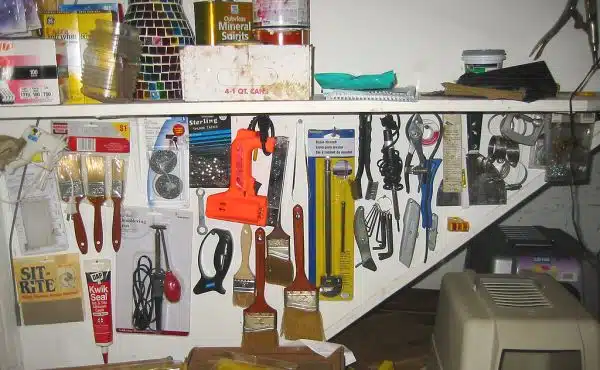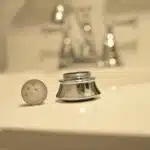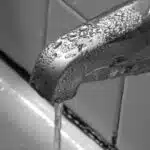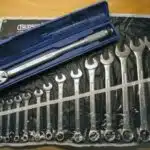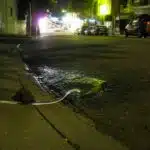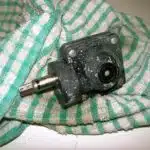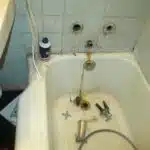As a plumbing professional, it is imperative to have a good understanding of the various tools and equipment that are necessary for completing any job efficiently. One such tool that every plumber should be familiar with is the basin wrench. This essential tool is crucial for replacing or repairing faucets, sinks, and other plumbing fixtures.
In this article, we will delve into the intricacies of using a basin wrench effectively. We will explore the different types of basin wrenches available in the market and offer tips on how to use them correctly. Whether you are an experienced plumber or just starting out in the industry, this guide will provide you with valuable insights on how to maximize the potential of your basin wrench while serving your clients with exceptional service.
Understanding The Anatomy Of A Basin Wrench
Understanding the anatomy of a basin wrench is essential before using it efficiently. A basin wrench is a specialized tool designed for tightening or loosening nuts that are in hard-to-reach places, such as those beneath a sink. It has two primary components: the handle and the head.
The handle of a basin wrench is relatively long and provides leverage to turn the head, which is located at one end. The head consists of two jaws that can be adjusted to fit around nuts that are difficult to reach. One of these jaws pivots while the other remains stationary, providing enough grip to turn the nut without slipping.
To use a basin wrench efficiently, it is crucial to understand how each component works and how they interact with each other. When using a basin wrench, ensure that the jaws are appropriately positioned around the nut to avoid any slippage or damage to both the tool and fixture. Additionally, make sure you have proper grip on the handle while turning it in a clockwise or anti-clockwise direction based on your needs.
Different types of basin wrenches are available in the market today. Understanding these different types will help you choose which one suits your specific needs best.
Different Types Of Basin Wrenches
As a plumbing professional, having the right tools in your arsenal is crucial to completing any job with ease and efficiency. When it comes to working on basin fittings, a basin wrench is an essential tool. This handy device allows you to reach into tight spaces where other tools cannot, making it easier to tighten or loosen nuts and bolts.
There are different types of basin wrenches available in the market, each designed for specific needs. One of the factors that differentiate these wrenches from one another is their sizes. Basin wrench sizes can range from as small as 1/2 inch to as large as 3 inches. It is essential to choose the right size for your specific job because using a wrong-sized tool can lead to damage or injury.
When shopping for a basin wrench, it’s always recommended that you invest in the best brands available in the market. Some of the top names in this industry include Ridgid, Irwin Tools, and TEKTON. These reliable brands offer durable and efficient tools that ensure longevity and precision in every use. By investing in high-quality products, you can enjoy peace of mind knowing that your tools will serve you well for years to come.
Transitioning into the next section about selecting the right basin wrench for your job: Now that we have covered different types of basin wrenches and best brands available out there, let’s move on to selecting the right basin wrench for your particular job.
Selecting The Right Basin Wrench For The Job
Basin Wrenches are essential plumbing tools that come in various sizes and shapes. Choosing the right wrench size is crucial when working on a project, as using the wrong size can cause damage to fixtures and fittings. Therefore, before starting a plumbing job, you must determine which basin wrench size will be appropriate for the task.
To select the correct basin wrench size for your needs, you should first determine the diameter of the nut or bolt you need to loosen or tighten. Basin wrenches typically come in 10-inch and 12-inch sizes, with each being suitable for specific tasks. The 10-inch basin wrench is ideal for removal or installation of smaller nuts and bolts found in tight spaces. On the other hand, a 12-inch basin wrench is more suited to larger jobs such as replacing a faucet.
Proper Basin Wrench usage requires choosing an adjustable basin wrench if you’re going to work on different-sized nuts and bolts. These types of wrenches are versatile and can save time by allowing you to adjust quickly according to your needs. Additionally, it’s crucial to use the correct end of a basin wrench when working on different parts of your sink or faucet system. Failure to use the right end can lead to poorly threaded fittings that may cause leaks or damage your plumbing fixtures.
Preparing Your Workspace
- Proper preparation is an essential part of any plumbing job, and the use of a basin wrench is necessary for many tasks.
- Gather the necessary materials before beginning, including the basin wrench, adjustable wrench, pipe wrench, and any other required tools.
- Clear the workspace of any other materials to ensure the job can be completed efficiently.
- Prepare the area around the workspace, making sure there are no objects that can be damaged or interfere with the job.
- Wear the appropriate safety equipment, including goggles and gloves, to protect against any debris or hazardous materials.
- Keep in mind that the basin wrench should be used carefully and with the correct force, as it can be difficult to control and may damage the plumbing system.
Gather Materials
When it comes to plumbing, having the right tools can make all the difference. One essential tool for any DIY plumber is a basin wrench. Before getting started with your project, it’s important to gather all of the necessary materials. For using a basin wrench, you’ll need the wrench itself and possibly some replacement parts for your sink.
You can typically find a basin wrench at most hardware stores or home improvement centers. Home Depot and Lowe’s are great options if you’re looking to purchase in-person. If you prefer online shopping, Amazon and Walmart also carry basin wrenches. Make sure to read reviews and check out different options before making your purchase.
In addition to the basin wrench, you may also need replacement parts such as washers or gaskets for your sink. These can be found at the same stores where you purchased your wrench or at specialized plumbing supply stores. It’s always helpful to have these on hand in case something needs to be replaced during your project. By gathering all of your materials beforehand, you’ll be prepared to tackle any plumbing job that comes your way!
Prepare The Area
As a responsible DIY plumber, it is important to prepare your workspace before tackling any plumbing project. One of the first steps in preparing your workspace is to clear any clutter or unnecessary items from the area. This ensures that you have enough space to move around and work comfortably without any obstructions. Take the time to remove any tools or materials that are not needed for the current job at hand.
Once you have cleared the area, it’s time to clean up the workspace. Cleaning involves removing any dirt, debris, or dust that may have accumulated in the area. If there is water present, make sure to drain it completely before beginning work on your plumbing project. Additionally, wiping down surfaces with a damp cloth can help prevent any unwanted particles from getting into your plumbing system and causing further damage.
Lastly, consider covering nearby furniture or flooring with protective materials such as tarps or drop cloths. This will help prevent any accidental spills or damage during the project. By taking these steps to prepare your workspace beforehand, you’ll be able to work more efficiently and effectively without having to worry about potential hazards or distractions. Remember that proper preparation is key when it comes to successfully completing any plumbing project!
Wear Safety Equipment
As a plumbing editor, I understand the importance of safety when it comes to working on any plumbing project. While it is crucial to prepare your workspace before starting any task, it is equally important to wear the appropriate safety equipment. Safety equipment can protect you from common hazards that you may encounter while working on your plumbing project.
Some common safety hazards to avoid include exposure to harmful chemicals, sharp tools or materials, and electrical shocks. Wearing safety goggles can protect your eyes from exposure to chemicals or flying debris, while gloves can protect your hands from sharp tools or rough surfaces. Additionally, wearing rubber-soled shoes can help prevent electrical shocks when working around water sources.
Overall, wearing proper safety equipment is essential for DIY plumbers as it helps prevent injuries and ensures a safe working environment. As you prepare your workspace for your next project, make sure to also gather the appropriate safety gear needed for the task at hand. This will not only keep you safe but will also allow you to work more confidently and efficiently without worrying about potential hazards.
Turning Off The Water Supply
Shutting off the water supply is a crucial step before removing an old faucet or fixture. This will prevent any water from flowing out and causing damage to the surrounding area. The process of turning off the water supply is relatively simple and can be done by following a few steps.
The first step in shutting off the water supply is to locate the shut-off valve. This valve is usually located near the fixture that you are working on, but it may also be located in a basement or utility room. Once you have found the valve, turn it clockwise to shut off the water flow.
After shutting off the water supply, it’s important to drain any remaining water that may be left in the pipes. To do this, turn on all of your faucets and let them run until no more water comes out. This will ensure that there is no excess water left in any of your pipes, which could cause leaks or damage when you start working on your plumbing fixtures.
Moving forward with removing your old fixture requires caution and focus to avoid damaging anything during this delicate process.
Removing The Old Faucet Or Fixture
As we move forward, we encounter an obstacle that requires careful handling. Removing rusted fixtures can be a daunting task, but it is necessary to make sure the new fixture or faucet is securely in place. The key to this step is ensuring that you don’t cause any damage to the sink surface, as this may lead to further repairs and expenses.
To begin, you will need to use your basin wrench to remove any nuts holding the old fixture or faucet in place. This may require some force, so be sure to grip the wrench firmly and apply pressure slowly and evenly. If you encounter resistance or find that the nut won’t budge at all, try using a penetrating oil like WD-40 or Liquid Wrench to loosen it up.
Once you have successfully removed all nuts and bolts holding the old fixture in place, gently lift it off of the sink surface. Do not force it off or pry it loose, as this may cause scratches or cracks on your sink. With your old fixture out of the way, you can now move on to positioning your basin wrench for the next step – attaching your new faucet or fixture securely in place.
Positioning The Basin Wrench
Basin wrench stability is critical to prevent injuries and damage to the plumbing fixture. The basin wrench should be held at the right angle for optimal wrench positioning to avoid slipping, which can cause injury or damage to the surrounding area. Before positioning the basin wrench, ensure that the water supply is turned off.
To position the basin wrench correctly, start by placing it over the nut that needs tightening or loosening. The jaws of the basin wrench should be positioned so that they are parallel to the direction of rotation needed. Next, adjust your grip on the handles until you feel confident in your ability to maintain control of both hands. Keep a firm grip on both handles while maintaining a stable stance.
Here are four tips for ensuring optimal basin wrench positioning:
- Position yourself in front of the nut you need to tighten or loosen
- Keep your feet shoulder-width apart for a stable stance
- Use your non-dominant hand to provide additional support
- Maintain a straight posture with your back and shoulders
Now that you have positioned your basin wrench correctly, it’s time to adjust its jaws. This will ensure that they fit snugly around the nut without slipping.
Adjusting The Jaws Of The Wrench
As the saying goes, a job worth doing is worth doing well. Therefore, before using a basin wrench, it is essential to ensure that the jaws are adjusted correctly. This way, you can achieve an optimal grip on the nut or bolt and avoid any mishaps during your plumbing project.
To adjust the jaws of the wrench, first, loosen the wing nut and slide the jaw in or out depending on your needs. Once you have set it to the desired size, tighten the wing nut securely. It is crucial to make sure that both jaws are aligned correctly before beginning work to ensure a proper grip.
When adjusting the jaws of your basin wrench, always remember that precision is key. A misaligned jaw can cause damage to both your tool and your plumbing fixtures. Take care to align the jaws accurately every time you use them, and you’ll be able to complete your plumbing jobs with confidence and ease.
With properly adjusted jaws on your basin wrench, you are now ready to move on to gripping the nut or bolt. Before doing so though, it’s important to keep in mind that this next step requires equal attention to detail as adjusting the jaws does. So let’s dive into how best to achieve a secure grip without damaging your plumbing fixtures!
Gripping The Nut Or Bolt
Proper grip techniques are essential when using a basin wrench. The wrench’s jaws should be positioned to grip the nut or bolt firmly, but not too tightly that it damages the fitting or causes slippage. A common mistake to avoid is using excessive force when gripping, which could cause damage to the tool, the fitting, or both.
When gripping the nut or bolt, ensure that the jaws of the basin wrench are in full contact with its surface area. This reduces the risk of slipping and ensures that all applied force is directed towards turning the nut or bolt. Another crucial technique for an effective grip is to position yourself correctly. Stand in a stable and comfortable position and ensure that you have enough leverage and space to turn the wrench easily.
To summarize, proper grip techniques are vital when using a basin wrench. Avoid common mistakes such as applying excessive force and improper positioning of the jaws. Remember to position yourself correctly for maximum leverage and stability when turning the wrench.
Moving on from gripping, we will now discuss how to loosen nuts or bolts with a basin wrench.
Loosening The Nut Or Bolt
After gripping the nut or bolt with your basin wrench, the next step is to apply pressure. This is where your strength and patience will come into play. Slowly turn the wrench counterclockwise, using a steady amount of force to loosen the nut or bolt. Be careful not to apply too much pressure at once, as this can damage the plumbing fixture or cause injury.
If you find that the nut or bolt is still stubbornly refusing to budge, you may need to use lubricant. Apply a small amount of lubricant such as WD-40 to the threads of the nut or bolt and let it sit for a few minutes before trying again. The lubricant will help loosen any rust or debris that may be preventing the nut or bolt from turning.
Remember, applying pressure and using lubricant are important steps in loosening a stubborn nut or bolt with your basin wrench. With practice and patience, you’ll become an expert at using this tool and tackling plumbing projects with ease. In the next section, we’ll discuss how to remove the nut or bolt completely from your plumbing fixture.
Removing The Nut Or Bolt
Now that you have successfully detached the water supply lines from the old fixture, it is time to remove the nut or bolt holding the faucet in place. This step can be tricky, especially if the hardware has been rusted over time. To avoid any mishaps, make sure to wear gloves and eye protection before attempting to loosen the nut or bolt.
If you encounter a stubborn nut that won’t budge, try using a penetrating oil such as WD-40 to break up any rust or corrosion. Apply a generous amount of the oil and let it sit for at least 15 minutes before attempting to turn the wrench again. Another common mistake is not using enough force when turning the wrench. Don’t be afraid to apply some pressure, but be careful not to overdo it and damage surrounding fixtures.
Breaking a rusted nut can take some patience and persistence, but with proper technique and tools, it can be done safely and effectively. Once you have successfully removed the old fixture, inspect the area for any damage or leaks before proceeding with installing your new faucet or fixture.
Transition: Now that you have removed the old faucet or fixture, let’s move on to installing your new one.
Installing The New Faucet Or Fixture
As the saying goes, “out with the old and in with the new.” Now that you have removed your old faucet or fixture, it’s time to install the new one. Before beginning, make sure to read and follow the manufacturer’s instructions carefully.
First, attach any necessary mounting hardware to your sink or countertop. Then, place a thin layer of plumber’s putty around the base of the faucet or fixture to create a watertight seal. While tightening the nuts or bolts, be careful not to over-tighten them as this can cause damage.
When installing a new faucet or fixture, it is common to run into some issues. To troubleshoot any problems you may encounter during installation, refer back to the manufacturer’s instructions or seek advice from a professional plumber. Additionally, proper maintenance is key for ensuring your new fixture lasts for years to come. Remember to regularly clean and lubricate any moving parts and check for leaks.
Moving forward, tightening the nut or bolt is an important step in completing your installation. Keep in mind that over-tightening can lead to damage while under-tightening can result in leaks. By following these tips and taking proper care of your new faucet or fixture, you can enjoy its functionality and beauty for years to come.
Tightening The Nut Or Bolt
To tighten the nut or bolt using a basin wrench, you will need to grasp the tool at its base and position it onto the nut. Next, slide the jaws of the wrench over the nut and adjust them so that they fit snugly around it. Once in place, rotate the wrench clockwise until you feel resistance, indicating that the nut is being tightened.
One common mistake when using a basin wrench is not positioning it correctly onto the nut or bolt. This can cause damage to both the tool and the fixture, as well as make it difficult to properly tighten or loosen. Another mistake is not ensuring that the jaws of the wrench are securely positioned around the nut or bolt before attempting to turn it. This can lead to slipping and potential injury.
In order to avoid these common mistakes, take your time positioning and adjusting the basin wrench before tightening. Be sure to double-check that it is securely in place before applying pressure. With proper technique and attention to detail, using a basin wrench can be an effective way to tighten nuts and bolts in hard-to-reach places.
Now that you have successfully tightened your fixture with a basin wrench, it’s time to turn on your water supply. But before doing so, make sure to check for any leaks around where you have worked. If there are no leaks present, slowly turn on your water supply and test out your fixture for proper operation. Congratulations on completing this task!
Turning On The Water Supply
Once you have successfully installed the new faucet or made repairs to an existing one, it is time to turn on the water supply. This step is crucial to ensure that water is flowing through the plumbing system and reaching the faucet. Before turning on the water supply, make sure that all connections are tight and secure.
Common mistakes when turning on the water supply include forgetting to turn off any valves that were closed during installation or repair. This can cause leaks or even damage to the plumbing system. Another mistake is turning on the water supply too quickly, which can cause a surge of pressure and damage to pipes or components.
If you encounter any issues with turning on the water supply, troubleshooting may be necessary. Check for leaks or drips in any connections or joints. It may also be helpful to check for blockages in the system by running water through all faucets and fixtures in your home. If issues persist, consult a professional plumber for assistance.
Now that you have turned on the water supply, it is important to test for leaks before using your faucet. This will help prevent any further damage to your plumbing system and ensure that everything is working properly. To test for leaks, run water through your faucet for a few minutes and inspect all connections and joints for any signs of moisture or dripping. If you do notice any leaks, tighten connections as needed or contact a professional plumber for assistance in repairing them.
Testing For Leaks
After successfully turning on the water supply, it’s time to move on to the next step: installing your basin. But before you do that, you’ll need a tool that can make the process much easier and efficient – a basin wrench. This versatile tool is designed specifically for tightening nuts and bolts in hard-to-reach places, such as those found under sinks.
Using a basin wrench is relatively straightforward. Begin by positioning the adjustable jaws of the wrench onto the nut you need to tighten or loosen. Then, turn the handle clockwise or counterclockwise to tighten or loosen the nut respectively. With its long handle and pivoting head, a basin wrench can easily reach tight spaces without requiring excessive force or awkward angles.
While using a basin wrench can save you time and effort during installation, it’s important to remain vigilant for any leaks that may occur later on. Common leaks include those around joints and connections between pipes and valves. If you notice any signs of leakage, such as dripping water or dampness in surrounding areas, don’t hesitate to take action. Troubleshooting leaks early can prevent further damage and ensure your plumbing system remains in top condition.
Conclusion
The basin wrench is an essential tool for any plumber or DIY enthusiast. Understanding its anatomy, different types available, and selecting the right one for the job will ensure a successful plumbing project. Before starting any work, it’s important to prepare your workspace and turn off the water supply. Once you have installed the new faucet or fixture, use the basin wrench to tighten the nut or bolt securely. Finally, turn on the water supply and test for leaks.
In conclusion, a basin wrench is a simple but effective tool that can help you tackle various plumbing projects with ease. Understanding how to use it properly will save you time, money, and frustration in the long run. Whether you’re fixing a leaky faucet or installing a new fixture, having a quality basin wrench on hand is essential for any successful plumbing project. So next time you need to do some plumbing work around your home, be sure to have your trusty basin wrench at hand!
Image Credits
- “20081121 – utility room organization – 0 – 172-7245 – main tool store” by Claire CJS (featured)

